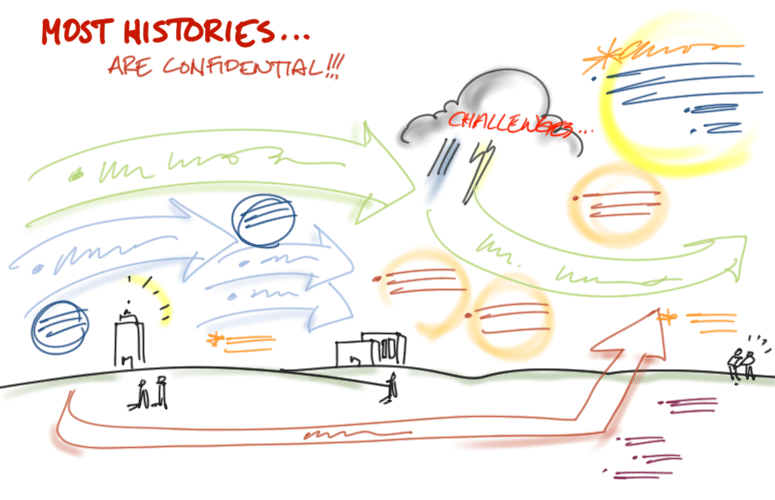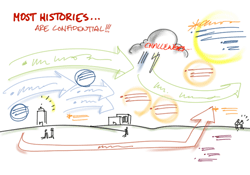My horticulture teacher, Alan Chadwick, used to talk about the use of “expectation and surprise” when designing gardens. You would follow a path, or round a corner, to find – suddenly – a broad vista or spectacular herbaceous border that you had no idea would be there. History mapping with groups is similar, in a way. Perhaps what isn’t similar is that the group knows, from reviewing the agenda at the beginning of the meeting, that they’ll spend some time discussing the history that brought them to wherever they are today. The process is fully visible. The surprise is that, usually, it’s like nothing they expected.
There is no other practice or activity in my facilitation repertoire that is as consistently underestimated by clients and the groups that they lead or are planning for. A common reaction to my suggestion that exploring the group or organization’s history would be a helpful way to begin is, “Well, ok, we can do that. But I don’t think it needs to take a lot of time.” It’s typically the same person, as much as anyone else in the group, who then doesn’t want to stop or move on once we’re in the activity. And it’s not uncommon for the history to turn out to be one of the highlights of the meeting, remembered fondly or even in awe, by those who were there.
I think there are multiple reasons for this phenomena. The first is that most people don’t spend time talking about the past in an extended way. Anecdotes may be a common way of instructing a newcomer in the dos and don’ts of an organization, but telling the stories of what happened one after the other and then looking across them over time doesn’t seem to happen much, if at all. We’re taught to look forward. At the same time, people arrive in organizations at different times and in different roles. There are typically all kinds of events that have shaped their environment that they are completely unaware of. They may also be unaware that others see different parts of the history that they don’t and that what they see shapes their behavior.
I remember a story that David Sibbet told a few years ago. He had been working with a law firm and at a certain point in the meeting, felt that they were stuck. He decided to put aside the process they were in the middle of and asked instead for the participants to talk about what it was like when they went to law school: what they had expected, what school was like, how they imagined the career they would have when they graduated. And he asked them to do this in a particular way. He began with the group that had gone to school in the 60s, then the group from the 70s and so on. What they discovered was that, depending on when they had been trained, they held very different perspectives and expectations, based on what the practice and training in law had been like at that time. Doing the exercise allowed them to see something they hadn’t before: differences and patterns that were shaping – and complicating – their interactions without them knowing why.
Years ago I facilitated a history for a group that was facing a particularly tough time, a situation more severe than any of them had ever experienced. Yet they discovered as they told each other the story of their department that the department itself, years before any of them had joined, had survived an equally hard challenge. Only one member of the group had known the people who had been there and turned the situation around, but that was enough, once the story surfaced, for the group to realize that their department had a history of facing tough moments and succeeding. It was a legacy that they could carry forward, if they rose to the challenge. They continued the meeting with an entirely different attitude than the one with which they’d begun.
Perhaps the most intense, and certainly the longest, history I ever supported was at Alyeska, the company that runs the Alaskan pipeline. I was working with Frank Johnson, an internal consultant at Alyeska, and we decided that I would record the session while he facilitated. We had a large group and limited board space for the charts I would work on – more than eight feet, but not a lot more. The organization had complex and occasionally traumatic history (I remember drawing a large slick for the Exxon Valdez incident) and, once the ball was rolling, everyone had something to say. I kept thinking we would wrap up soon; Frank kept feeling that they group needed to have the conversation they were having. I’m sure he was right, but I’ve never produced such a dense, nearly illegible chart in my life. I doubt that it mattered much. The real magic was in the conversation.
Having said this, seeing a history emerge is a strong support to the storytelling that brings the history to life. It also allows a group to go back over the history, once the story has been told and to look for patterns or insights. Years ago I worked with perhaps the only group I’ve had that wasn’t responsive to telling their history. The problem was that half the group had done a similar exercise a few weeks before. But the other half hadn’t, so I faced a dilemma. Keep half the group from being bored, but leave the other half in the dark? Not a good idea, since the history was in preparation for thinking strategically about the future. I pushed on, painfully aware of the participants who were checked out. Then something funny happened. As the group brought us up to the present, I asked a follow-on question: given what you’ve told me, what insights do you have? That question changed everything. Suddenly the whole group was alive! Like (unfortunately) many groups, their recent history had been pretty painful. They wanted to avoid repeating it at all costs. Being able to see it in front of them made it easy to reflect on what they would need to change.
Histories allow groups to literally all get on the same page, bringing new members on board and giving the old hands a chance to share their experience. They allow people to celebrate the highs and acknowledge (and begin to let go of) the lows. Groups see accomplishments they may have overlooked in the heat of work and recognize forces that have been at play. Seeing these in front of them can be, in the words of a recent participation, “a revelation”. A well-told and recorded history lays the groundwork for wisdom, while strengthening old relationships and beginning new ones. And it’s – unexpectedly – fun. Though it may take longer than you’d imagined.


Doing a history map was critical to ultimately reaching an aligned vision and our stratgic bold steps to move forward. At first, we reacted the same way as Tom describes – “Well, OK, I suppose we can do that…” That exercise was so important to integrating the newer people with the longer term and the different functional groups and levels – it gave us a common foundation from which to work and it answered our questions, both spoken and unspoken, so we could move on with a common undertandng of where each of us had been.